Odd feathers (7 August 2003)
Some of you will know that I have a bit of a reputation for spotting odd feathers. Quite a lot of this photo collection is of birds that have undergone accidental moult of an odd feather. (The Americans tend to call this adventitious molt.) The key point is that when a bird does this, the new feather is of the type appropriate for the next generation; thus, a juvenile bird that loses a feather accidentally will grow a new one of the 'adult' shape/ colour. This can then provide a highly educational look at juvenile and adult feathers all in the one bird.
Before getting into the photos, I should comment that the particularly bright sunlight that we've had often in the last four or five weeks can give a very harsh look to some of the photos, and mess up colour comparisons between photos, but within one image it should still be OK. I decided not to try to doctor the images to even up the colour balance.
I find that Whitethroat Sylvia communis is one of the commonest species that moults odd tail feathers. The three photographs below show, in the middle, a normal juvenile Whitethroat with all twelve juvenile feathers. The Whitethroat on the top has accidentally moulted t5 (the second outermost) on the right-hand side. It is a little shorter because it's not quite fully grown, but the most obvious point is the amount, and the clarity, of white colour at the tip and around the edges of the feather. Compare it with t5 on the left-hand side of the same bird, and with the two t5 feathers on the 'normal' bird in the middle. This white is what you'd find on an adult bird after its moult, but they do that in Africa and look pretty worn by the time they get back here in spring, so we don't see it as obviously then.
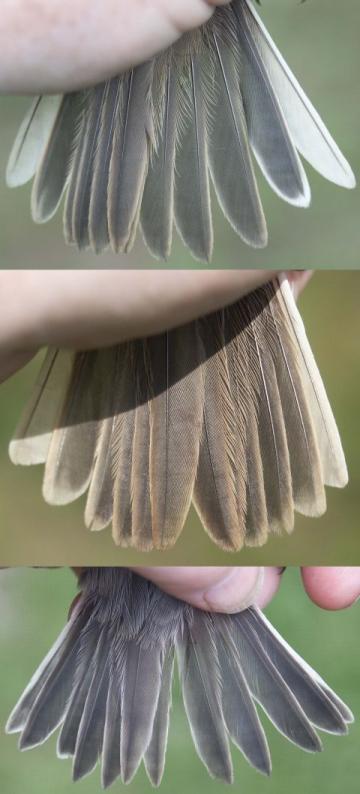
The bottom photo is of a juvenile Lesser Whitethroat Sylvia curruca, which is not a species that many of get used to seeing in Cheshire/ Merseyside. This one (caught at Woolston, 3 August) has obvious growth bars where we can see several days of growth cycles, but careful inspection shows that t4 (the third outermost) on the left-hand side is an adventitiously-grown feather, again not quite full length, and with no growth bars. Its shape is much rounder - compare with t4 on the right-hand side - and also it has a little white around the tip and its outer edge. Lesser Whitethroat adults typically have a lot of white on the outermost, some on the next feather and a little on t4, like this one.
I don't find tails all that easy to photograph, and many of the tails have the feathers not as well-arranged as I'd like, so you have to count the feathers (six in each half of the tail) but I hope the effect is visible.
A posed photo of the two species, but not these two individuals, is here:
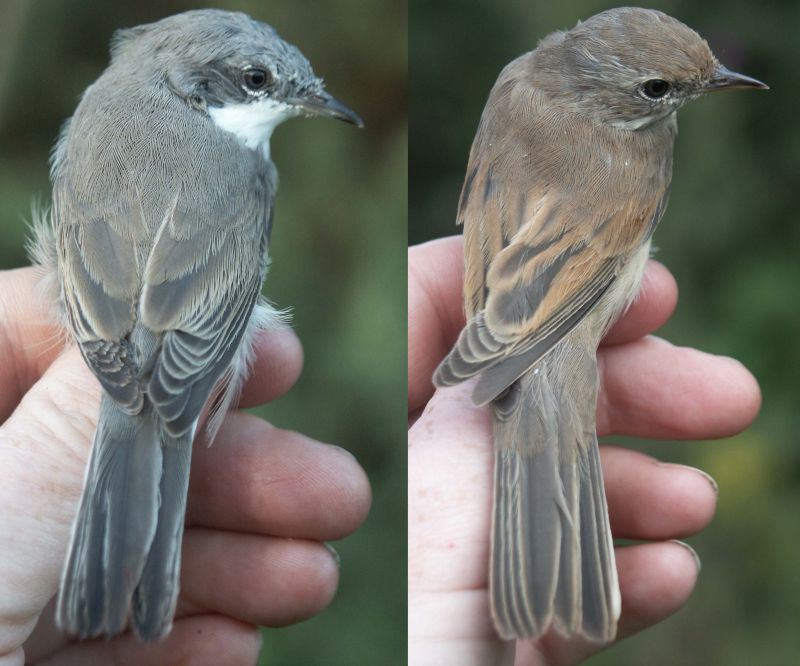
Whilst we're looking at tail feathers, both of my main autumn sites (Woolston and Oxmoor Local Nature Reserve, Runcorn) are in the Mersey valley, one of the strongholds of Willow Tit Parus montanus, a bird on the Red List of species of conservation concern. The shape of tail feathers is the only way given by Svensson for ageing them, after the obvious juvenile feathers have been shed in the post-juvenile moult. The photo below shows the comparison, with the adult (on the left, obviously!) one of the most perfect that I've ever seen.
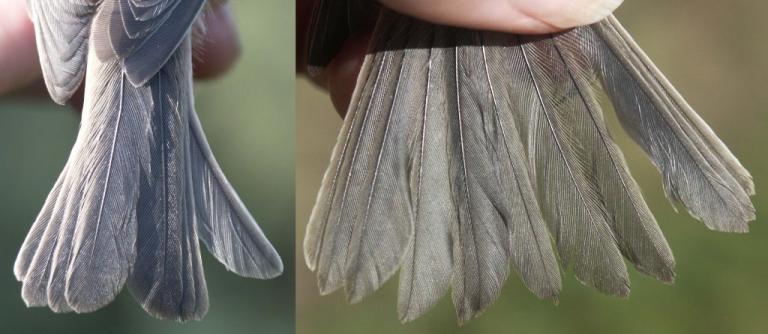
Another classic effect on tail feathers is the growth bars exhibited by the juvenile Sedge Warbler (below), caused by big differences in food from one day to another whilst they're growing feathers in the nest. The growth bars really poke your eye out on the tail, but are much less visible on the wing (of the same bird): we often see this, but why?
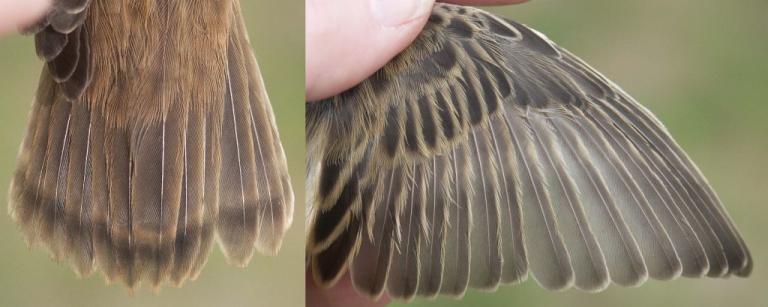
I mentioned in my last posting about sexing first-year Blackcaps after they start their post-juvenile moult. The photos below show three recent examples. The top one is an obvious male, with only a few brown feathers left near to the front of its head. The middle one is another male, not a high quality photo, but now with black mostly around the edges of its head and the crown yet to be moulted. The lowest photo is the trickiest, but with care (try magnifying the image in your viewer) you can just see there is one quill with a brown feather emerging from it, showing that this is a first-year female. This was the first new feather to be grown on this bird's head, and took some searching to find! (The crown feathers were parted deliberately for the photo).
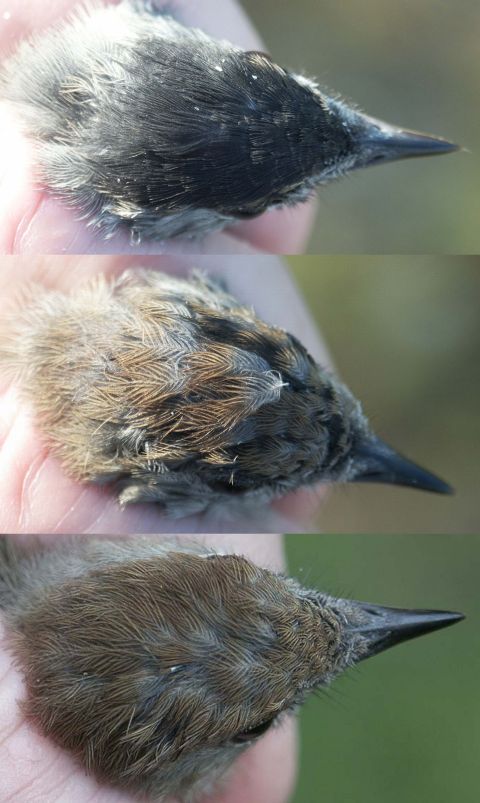
The next photograph (below) shows post-juvenile moult in a Chiffchaff Phylloscopus collybita. This bird is moulting its tertials and inner greater coverts, retaining four old greater coverts (ogcs). According to Jenni and Winkler (Moult and Ageing of European Passerines, 1994), 56% of their sample of first-year Chiffchaffs moulted some tertials, with 30% of the total moulting all three (like this bird). Again, from their figures, birds can moult from none to all of their greater coverts, but keeping 4 ogcs - as this bird has - is the most common. In principle, we should be able to age Chiffchaffs by seeing moult limits within the greater coverts, ageing them as 3 or 4 in autumn and also as 5 or 6 in spring, since almost no birds moult any greater coverts in winter or spring. (Beware that many birds, both 5 and 6, moult some tertials in spring in their pre-breeding moult so contrast in the tertials is of no use in ageing in spring). However, the sentence before last did start with the phrase 'in principle' and I have to say that I have almost never been able to see the moult limits within Chiffchaff greater coverts. But having a digital camera has opened my eyes to so many things that I hadn't seen before, so I plan to keep a close look for this next year.
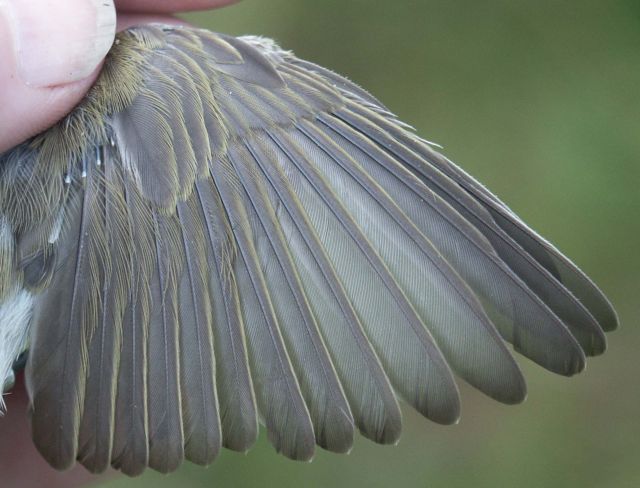
The adult Phylloscopus warblers can be a bit tricky even to get the species right when they're in heavy moult. In my first full year of ringing at Woolston (1981) when Chiffchaffs were scarce (I ringed 136 Willow Warblers and 7 Chiffchaffs, whereas now CHIFFs outnumber WILWAs) I caught a Chiffchaff in the middle of its moult. I mis-identified it as Willow Warbler - I wasn't used to seeing Chiffchaffs, let alone adults, and this was the first I had ever seen in moult - but retrapped it twice later in the month when it was easier to get right: on one occasion Dave Cross was with me and said 'that's a funny-looking Willow Warbler'.
The photo below shows three Chiffchaffs caught in the last ten days, all in the early stages of their full moult, having dropped innermost primaries (and tertials): none of these birds has its sixth primary (counting from the outside), so those ringers who base specific identification solely on 'emarginated sixth or not' would be in trouble. There aren't enough primaries present to do a conventional wing-shape assessment, either, but with the top bird, for instance, its second primary is obviously much shorter than p3,4,5 and with a Willow Warbler p2 would be much longer (p2 on the lowest bird is hidden; the middle bird shows dramatically why it needs some new feathers - all of its outer primaries, and secondary 1, have been snapped off.). Wing length can be helpful, with all female Chiffchaffs smaller than the smallest WILWA, but male CHIFFs and female WILWAs overlap in size. But don't forget what the birds look like: leg colour, buffy flanks, overall colour, forehead shape, all can help.
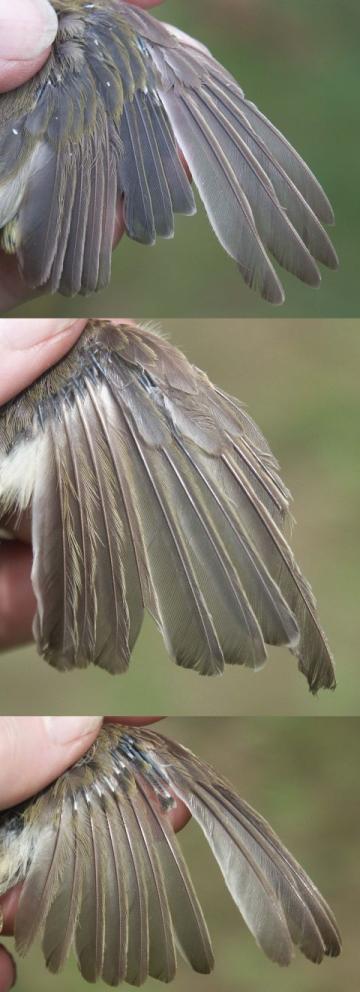
Willow Warblers move out quicker, so they moult earlier than most Chiffchaffs. In the last week I've had several adults that have almost finished moult, and Dave Riley has had a couple (known-age retraps) that had finished. This composite photo shows three:
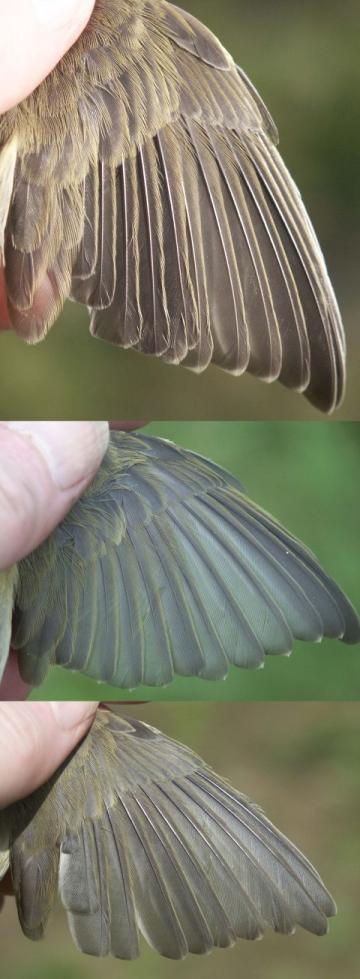
The apparently very different colours of these birds is just another trick of the light. In each bird there's only the outermost primaries and innermost secondaries still growing and completing the moult. The tertials have finished because they are moulted early, along with the inner primaries. The middle one is the really awkward one, where the primaries are fully grown and the only flight feathers still growing are the innermost three secondaries, all at stage 4 and within days of completing. The very fresh feathers have a lighter coloured tip to them that could be mistaken for bleaching by the unwary, but - unlike bleaching - it does not take the shape of the exposed part of the feather. When they've finished moulting, as all of these birds will have done within days of taking the photo, we have to look quite hard to age them. (See next posting). As well as the tail shape, which is usually helpful, and the fact that adults are usually less yellow on the bellies than first-year birds, when looking at the wings this is the time of year when we have to do a flip in mind-set: for the last two months or so, the birds with really fresh plumage have been the juveniles, with adults looking worn, whereas now the adults have slightly fresher plumage than juveniles. The adults' longest feathers are a couple of weeks old whereas those of the juveniles are typically a couple of months old, although second broods might have only recently emerged (and will have bare bellies etc, obviously 3J rather than 3). The difference between a couple of weeks and a couple of months might not sound like much, but remember that the plumage of Willow Warblers abrades pretty quickly, which is no doubt why they need two full moults a year.
On to the final species for this collection. Just because they're lovely birds to handle - and I'm showing off that I've ringed 17 Grasshopper Warblers Locustella naevia this year at Oxmoor Local Nature Reserve, Runcorn - a comparison of a juvenile and an adult GRAWA:
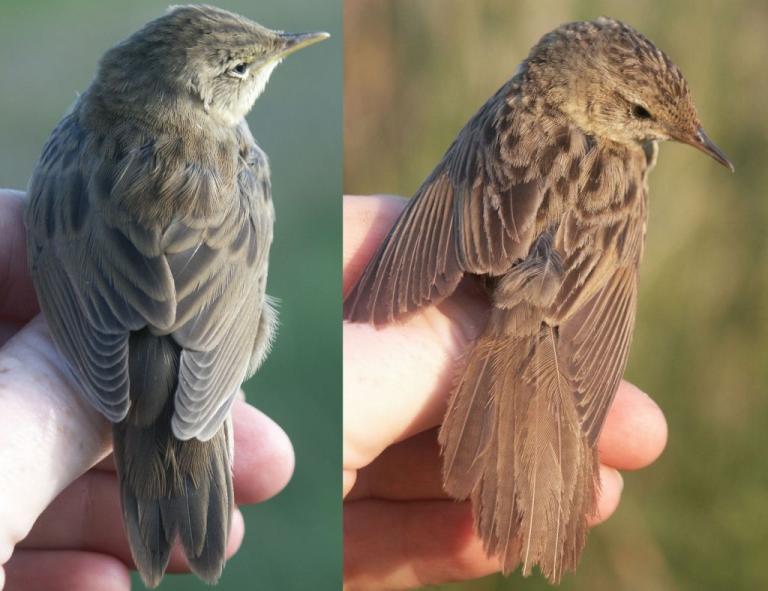
The degree of wear on all feathers is obvious on the adult, with beautifully soft fringes on all of the juvenile's feathers - you can almost feel it in the photograph, and you can probably 'age them in the bag'. Again, I advise caution in looking at the overall colour which is probably a sunlight effect - look at the difference in apparent colour of my fingers - and the bright early-morning sun on the adult photo gives a reddish-brown cast to all colours. Despite this extensive wear, this is another species that will fly to Africa before starting its full moult. The undertail coverts on Grasshopper Warblers are probably the longest, relative to the tail length, of anything that we handle, as shown below, which also illustrates the extent of wear on an adult tail, and the undertail coverts themselves as well.
.jpg)
The juveniles undergo quite an extensive post-juvenile moult of their head and mantle, which can make them look quite scruffy:
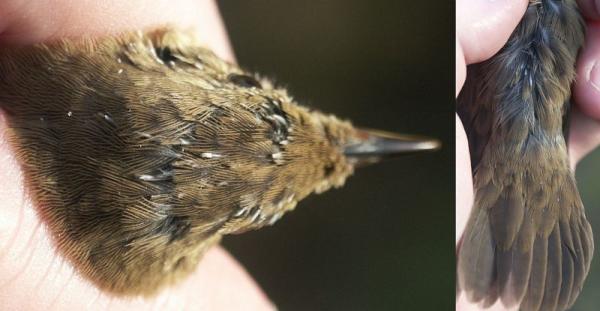
However, to finish this posting where it started: even with this species, I found one with odd feathers, although I'll admit I didn't notice it until looking through the photos:
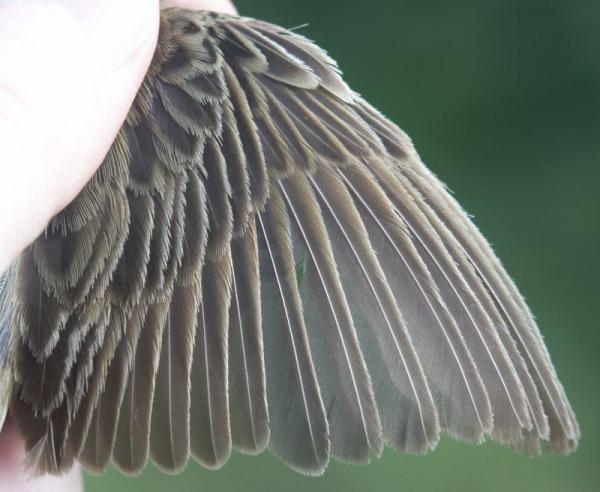
This is obviously an adult Grasshopper Warbler, with worn primaries, but it has a new (ish) innermost primary. Since I didn't notice it on the bird in the hand, I don't know if it was symmetrical on both wings. But, as well as the new p1 (innermost), isn't that a moult limit between the (fresh) small feather of the alula ('A1') and the (worn) middle and large alula ('A2 and A3')? And the primary coverts (pcs) confuse me as well: the innermost three look fresh, buff-tipped, and rounded (like the carpal covert) whereas the outer pcs look frayed and more pointed. Adults are supposed to have a full moult in Africa, so what happened to this one?
David Norman.